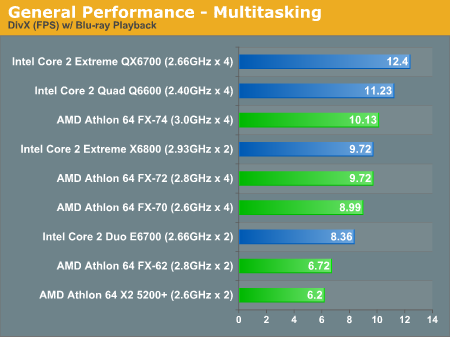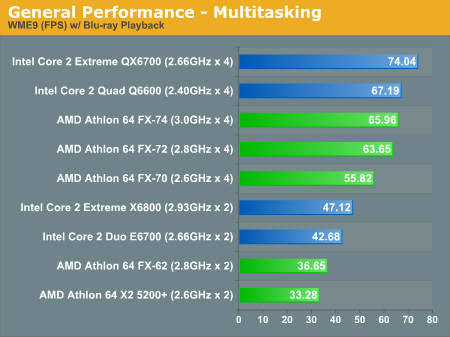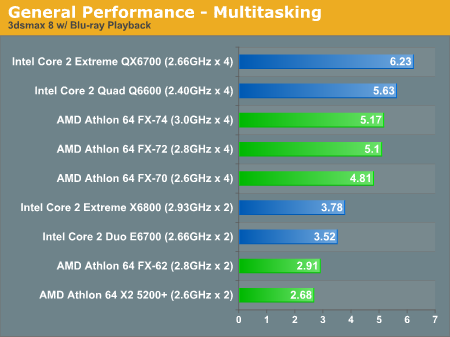AMD's Quad FX: Technically Quad Core
by Anand Lal Shimpi on November 30, 2006 1:16 PM EST- Posted in
- CPUs
Multitasking Performance
When we were trying to think up new multitasking benchmarks to truly stress Kentsfield and Quad FX platforms we kept running into these interesting but fairly out-there scenarios that did a great job of stressing our test beds, but a terrible job and making a case for how you could use quad-core today.
Without a doubt, in the next two years the number of applications that see a benefit when running on four cores will increase dramatically. Even multitasking under Windows Vista will make the argument for more cores easier (simply opening a new Explorer window in Vista will eat up 10% of the CPU time of a Quad FX system), but our Vista benchmarks are not yet complete and we wanted to have something to showcase for this review.
While working on our Quad FX article we also happened to be working on a follow-up to our HDCP Graphics Card Roundup, focusing on H.264 decoding performance in Blu-ray titles. A light bulb went off and we had our benchmark: how many cores do you need to watch a high bit-rate Blu-ray movie and do something else at the same time on your PC?
The movie we used was Xmen III, encoded in H.264, and featuring bitrates in excess of 40Mbps at times. Our benchmark starts at the beginning of Chapter 18 and continues until our background tasks are complete. This particular segment ranges in bitrate from 13Mbps up to above 40Mbps, with the average falling in the 18 - 24Mbps range.
We played the movie in the foreground, while in the background we either ran our Cinebench test, encoded a DivX movie, encoded a WME9 movie or performed our 3dsmax test.
The two rendering tests are important because rendering can take a bit of time and it might be nice to entertain yourself with a movie while your rendering completes; after all, what's the point of having $1000 worth of CPUs if you can't use them for entertainment?
The two encoding tests are also important because being able to encode and decode at the same time is a fundamental requirement for a DVR, and at some point the next-generation of media center PCs will need to be able to decode high bitrate HD movies while encoding others. We chose to include both DivX and WME because DivX runs much better on Intel CPUs, while the standings are a bit closer under WME, to give you a better overall impression of how the two platforms handle these heavy multitasking scenarios.
Our first test involved us playing back the BD title while running our multi-threaded Cinebench test; we reported the Cinebench score upon its completion:

The dual core processors all fall to the bottom of the list and basically perform like single-core CPUs while decoding the Blu-ray movie. The quad-core setups do much better and perform very well, but all of the CPUs in this test were able to run without dropping any frames in the BD movie.
Making things a bit more difficult, our next test had the same movie playing back but this time we ran our DivX encoding test in the background. We reported the DivX encoding frame rate upon completion:

Performance is pretty much what you'd expect, although Intel's superior DivX encoding performance results in the Core 2 Extreme X6800 doing almost as well as the FX-74. What you don't see however is how well these systems played back the Blu-ray movie; none of the dual core setups were able to play the BD movie smoothly, not even the Core 2 Extreme X6800. The movie was basically unwatchable due to all of the pausing and stuttering.
All of the four core systems played the BD movie fairly well; although they all dropped some frames, it wasn't enough to totally ruin the experience.
Next up we tried playing our BD title while running our WME9 test, and found similar results:

Once again, none of the dual core platforms were able to play the BD title even remotely smoothly. The quad-core setups were able to play the movie while encoding, but still managed to drop some frames (not enough to ruin the experience though).
Our final multitasking test has us playing the same BD title while running our 3dsmax 8 render test:

Much to our disappointment, none of the systems could handle this workload without ruining the movie playback; even the quad-core setups had troubles. We're not talking a few dropped frames, but rather the movie playback would be completely stopped at times. It looks like we may have a scenario for either more GPU assisted H.264 decode or an 8-core Quad FX platform in the future.










88 Comments
View All Comments
mino - Friday, December 1, 2006 - link
If you would bother to read, you would see those IDLE numbers are Without C'n'C.Witch C'n'C the IDLE number is be more like 250W than 380W.
mino - Sunday, December 3, 2006 - link
Hell, I should REALLY read after myself more thoroughly...JKing76 - Thursday, November 30, 2006 - link
What have you got against pickup trucks?Genx87 - Thursday, November 30, 2006 - link
I think it is safe to say Intel has caught AMD with its pants down this round with their Core 2 Duo line of products. Intels product line is much more compelling and performance\watt is scary good for Intel.Hell Intel's offering must be good, it got me to buy their product for the first time in nearly a decade! ;)
mino - Friday, December 1, 2006 - link
Actually not.AMD has caught Intel pants down in 2003. It took Intel 3!!! years to come back to game.
Those 3 yrs Intel was NOT price competitive.
Intel has just caught up in midle of 2006, this was to be expected and WAS expected by AMD.
AMD is about to catch up to Intel after 1 year..
This 1 year AMD IS price competitive, hence it is still in the game..
The 2008 Intel CSI may catch AMD with pants down. May.
Actually, in 2008 AMD will have some 30-35% marketshare and be so well entrenched in the corporate market that some mild performance(as now) hiccup is not gonna hurt them in any serious manner.
Roy2001 - Thursday, November 30, 2006 - link
If you need quad-core/CPU system, kentsfield is a much better choice, no question asked.sprockkets - Thursday, November 30, 2006 - link
Why is it that just putting the other 2 cores on the same package reduces power consumption so much?Anyhow, yeah, Intel is ahead, though this would be good for servers, not for desktops. Even so, Intel for now is still better.
But, I found for perhaps 90% of all people, an old s754 board with a $45 dollar Sempron works fast enough. I wish Anand would check out the new C7 processor mini ITX boards to see how well it works for so little power consumption.
Furen - Thursday, November 30, 2006 - link
The QX6700 pretty much draws twice as much power as the E6700, the big benefit of going for quad-core in a single system is that you only have one motherboard, harddrive, one set of RAM sticks, one video card, etc. The 4x4 is horribly engineered, I think even 400W at load is too much for two Opterons at 3GHz.mino - Friday, December 1, 2006 - link
Two Opterons DO NOT employ 8000GTX usually ...Two Opterons do have 95W TDP(lower voltage) ... compared to 125W for FXs
Two Opterons are available in 68W TDP ...
Two Opterons are NOT available in 3GHz flavour ....
Two Opterons are twice as expensive ....
Furen - Thursday, November 30, 2006 - link
The 4x4 motherboard, that is...